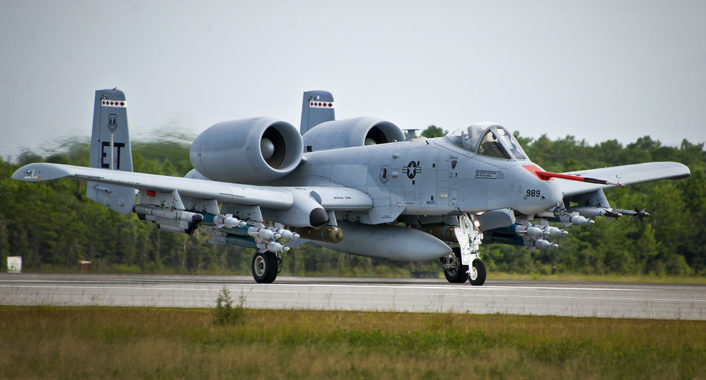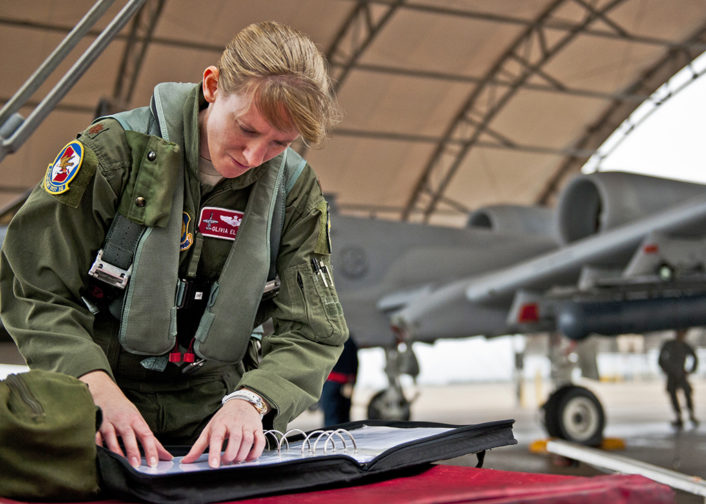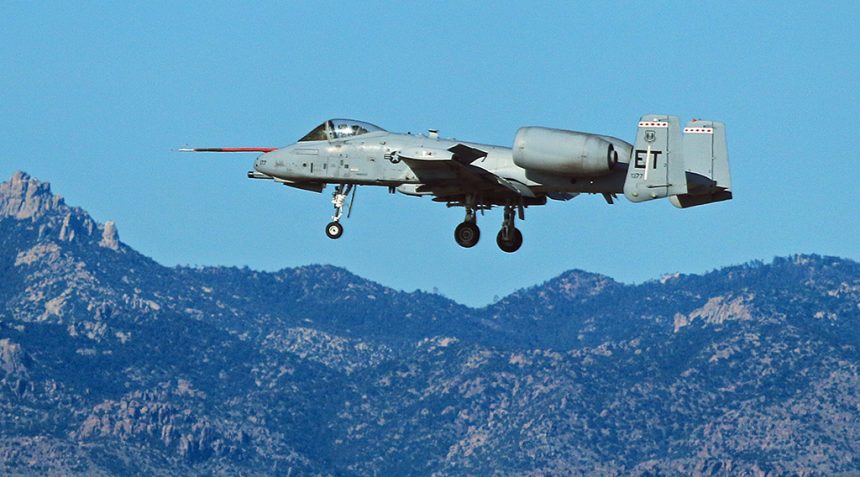Photo Shows Uniquely Configured A-10 Exercising with Davis-Monthan Warthogs.
Photographer Lance Riegle captured an interesting photo while sitting in the second floor of the B-17 display building at the Pima Air & Space Museum across the road from Davis-Monthan AFB in Tucson, Arizona on Tuesday, March 5, 2019.
Riegle was in Tucson to cover the first performance of the F-35A Lightning II at the Heritage Flight Conference along with other stories for TheAviationist.com. Riegle, 21, from Dearborn Heights, Michigan was watching a number of A-10s returning from training sorties in the late afternoon on Tuesday, a common sight near Davis-Monthan. The sharp-eyed Riegle noticed something different about one of the aircraft and, from inside the building nearly a mile away, he grabbed his Canon EOS-70D with a Canon 100-400mm lens and started shooting.
“I was looking out the window, and I just noticed the large orange probe sticking out of the front of the plane. At first I thought it may be some kind of new refueling probe,” Riegle said.
Most of the Warthogs commonly seen flying into Davis-Monthan, a hub of A-10 activity, wear the common “DM” tail code of the 355th Wing at Davis-Monthan. The aircraft spotted by Riegle wore a different “ET” tail code.
Some quick research on the aircraft’s tail codes and markings reveal that the A-10 is from 46th Test Wing at Eglin AFB, Florida. That itself is interesting, but the unique test/instrumentation probe made the aircraft even more interesting.

Large forward-protruding nose probes often contain various flight control sensors to record flight performance data during test flights. It was unusual to see such an instrumentation probe on an older aircraft such as the A-10, even though this aircraft has been spotted every now and then for years now.
As it turns out, the aircraft spotted and photographed by Lance Riegle is a unique testbed A-10 that may be powered by a blend of biomass-derived fuel and conventional JP-8 jet fuel, could be carrying new tactical communications devices and/or experimental load configurations.
For the unusual biomass fuel experiments, the biomass component of the special fuel mixture is derived from camelina, a non-food plant crop similar to soybeans. Apparently, the alternative fuel technology for the A-10 is not new. The first flight of the 50/50 blend of hydrotreated renewable jet fuel and JP-8 in this A-10 was made back in March of 2010.
According to the Air Force Research Laboratory at Wright-Patterson AFB in Dayton, Ohio, “The biofuel is produced from living matter that includes plant waste and animal fat, rather than a fuel produced through the geological process, such as coal, diesel and petroleum. Biofuels are environmentally friendly and form from renewable resources. Most of all, biofuels are helping to expand military energy sources, improving reliability while decreasing dependence on foreign fuel sources.”
Biomass alternative fuels can also be produced from organic sources such as algae and other plant oils, reducing the military’s reliance on fossil fuels to improve strategic supply security and reduce environmental impact.
The fuel tests on this A-10 from the 46th Test Wing at Eglin AFB, Florida began nearly a decade ago, and may have since concluded altogether. There was no way to tell by observing the aircraft in flight from a mile away.
We do know that these same unusual A-10s have also conducted flight tests using a centerline-mounted 600-gallon fuel tank in combination with a wide range of additional external fuel tank and weapons stores configurations. USAF test pilot Major Olivia Elliott of the 40th Flight Test Squadron of the 46th Test Wing at Eglin AFB, Florida has flown a similarly equipped A-10 with nose instrumentation to test numerous external stores configurations. Some of the test flights included performance testing in combat flying conditions such as high “G” loads and unusual flight attitudes.

Further flight tests on these unique nose-probe equipped A-10s of the 40th Flight Test Squadron, 46th Test Wing, include a near-instantaneous communications capability called “ROVER-5” (Remotely Operated Video Enhanced Receiver-5). The ROVER-5 feeds and shares data and video imagery to a small, arm-mounted touchscreen device about the size of an iPad-mini. New upgrades allow the ROVER-5s to share data with each other on the ground for tactical teams, while previous versions could only send and receive from the sensor aircraft, in this case, the special test A-10 equipped with a sensor-imagery pod. The capability tested on this special A-10 is called “NET-T”, and allows the ROVER-5s to communicate with each other on the ground using the special A-10 as a communications node.
One Air Force source at Eglin AFB, where the special A-10s are based, said, “This targeting pod enhancement can provide the commander real-time information videos, images, maps, coordinates or any file type from the forward deployed elements without relying on satellite radio or other forms of traditional communication.”
While we cannot say exactly what this special test A-10 was doing while flying with other conventionally configured A-10s from Davis-Monthan AFB over Tucson, Arizona on Tuesday, March 5, 2019, we can say for certain that this was a unique sighting of an interesting aircraft with a fascinating history.









